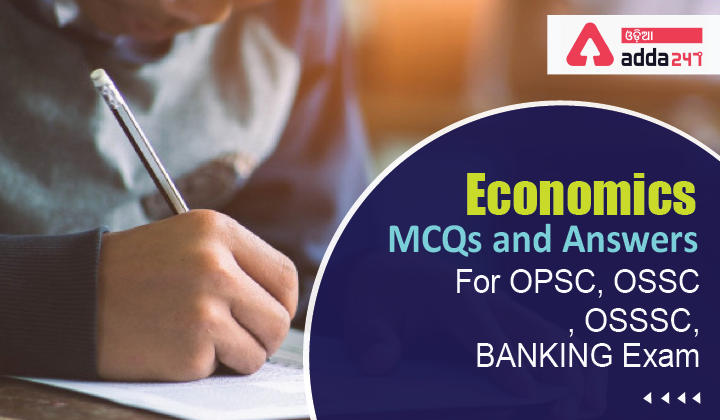Economics MCQs and Answers: Economics are very important for OPSC, OSSC, OSSSC & Other State Exams. Aspirants who are willing to apply for the various Government exams in 2022 must go through the topics of Economics for competitive exams, as Economics is a key part of the syllabus.
Download ADDA247 Odia APP – Appear Latest Exam Test Series & Live Classes
Q1.Income and consumption are?
(a)inversely related.
(b)directly related.
(c)partially related.
(d)unrelated.
S1.(c)
Sol. Consumption and income are directly related as the income rises consumption rises and as it decreases consumption also decreases.
Q2. What is the effect of deficit financing on economy?
- Reduction in taxes
- Increase in wages
- Increase in money supply
- Decrease in money supply
S2. Ans.(c)
Sol. Deficit financing means generating funds to finance the deficit which results from excess of expenditure over revenue.
The gapis covered by borrowing from the public by selling bonds or by printing new currency.
Printing new currency notes increases the flow of money in the economy.
Q3. As per the FSS Regulation, displaying FSSAI License/Registration Number at food premise is
(a) Optional
(b) Mandatory
(c) Non-obligatory
(d) Voluntary
S3. Ans.(b)
Sol. The Food Safety and Standards Authority of India, more popularly known as FSSAI, had come out with an order in September 2018, making food display boards mandatory.
Henceforth, the FSSAI licence/registration number and food safety display boards (FSDBs) must be displayed at all food establishments.
Q4. Pradhan mantri Suraksha Bima Yojana launch in which year?
(a) 2014.
(b) 2015.
(c) 2020.
(d) 2019.
S4. (b)
Sol. PM Suraksha Bima Yojana is a government- backed accident insurance scheme in india. It was formally launched by prime minister Narendra Modi on 8 May, 2015in Kolkata.
Q5.Micro economics deals with?
(a) The circular flow of income.
(b)The decision making of a single economic variable like demand.
(c) understanding unemployment.
(d) Economic growth.
S5. (b)
Sol. Micro- Economic’s is the branch of Economic’s which study Economic’s at individual level like demand, supply price etc.
Q6. Reserve Bank of India act?
(a)Govt.of India Act 1935.
(b) RBI Act 1934.
(c) Govt Act 1930.
(d) RBI Act 1959.
S6. (b)
Sol. RBI of India Act,1934 is the legislative act under the reserve Bank of India was formed. This act along with the companies Act,which was amended in 1936 , were meant to provide a framework for the supervision of banking firms in india.
Q7. Which of the following is included in National Food Security Mission (NFSM)?
(a) Wheat
(b) Pulses
(c) Rice
(d) All of the above
S7. Ans.(d)
Sol. The National Food Security Mission (NFSM) was launched in 2007-08 with a view to enhancing the production of rice, wheat, and pulses by 10 million tonnes, 8 million tonnes, and 2 million tonnes respectively by the end of the Eleventh five year Plan.
Q8. RTGS in banking sector stands for
(a) Real Time Gross Settlement
(b) Real Transactions Going Settlement
(c) Ready Transfer Gross Settlement
(d) Remittance Transfer Gross settlement
S8. Ans.(a)
Sol.Real-time gross settlement (RTGS) systems are specialist funds transfer systems where the transfer of money or securities takes place from one bank to any other bank on a “real-time” and on a “gross” basis.
Settlement in “real time” means a payment transaction is not subjected to any waiting period, with transactions being settled as soon as they are processed.
Q9. Inflation in India is measured on which of the following indexes or indicators?
(a)Cost of Living Index (CLI)
(b)Consumer Price Index (CPI)
(c)Gross Domestic Product (GDP) (d)Wholesale Price Index (WPI)
S9. Ans.(d)
Sol. Inflation in India is measured on the Wholesale Price Index (WPI).
The wholesale price index (WPI) is based on the wholesale price of a few relevant commodities over commodities available.

Q10. Open market operations refers to the sale and purchase of ______ by the RBI.
(a) Government securities
(b) Bullions
(c) Fixed property
(d) Foreign currency
S10. Ans.(a)
Sol. An Open Market Operation (OMO) is the buying and selling of government securities in the open market.
Central banks (In case of India, RBI) usually use OMO as the primary means of implementing monetary policy.
Q11. Which of the folowing sanitation campaigns was launched acros India on 2 October, 2014by the Ministry of Drinking Water andSanitation for rural areas?
(a) MisionVriksharopan
(b) Swach Bharat Mision
(c) Smart City Centre Scheme
(d) Pradhan Mantri Jan VikasKaryakram
S11. Ans.(b)
Sol.Swach Bharat Mision
was launched acros India on 2 October, 2014 by the Ministry of Drinking Water and Sanitation for rural areasto eliminate open defecation and improve solid waste management.
It is a restructured version of the Nirmal Bharat Abhiyan launched in 2009.
Q12. The two main components of GMPs essential for the success of the food safety system are
(a) Education and accomplishment
(b) Education and enforcement
(c) Written programs and implementation
(d) Manual and accomplishment
S12. Ans.(c)
Sol. The two main components of GMPs essential for the success of the food safety system are, Written programs and implementation.
Good manufacturing practices (GMP) are the practices required in order to conform to the guidelines recommended by agencies that control the authorization and licensing of the manufacture and sale of food and beverages, cosmetics, pharmaceutical products, dietary supplements, and medical devices.
Q13. Public Distribution System is aimed at
(a) Providing food security to the poor
(b) To prevent hoarding and black marketing
(c) To prevent overcharging by traders
(d) All of the above
S13. Ans.(d)
Sol.The Indian food security system (Public Distribution System) was established by the Government of India under the Ministry of Consumer Affairs, Food and Public Distribution to distribute food and non-food items to India’s poor at subsidised rates.
It helps in ensuring Food and Nutritional Security of the nation.
It also helps in stabilising food prices and making food available to the poor at affordable prices.
It also prevents overcharging by traders.
Thus, all the given options are correct.
Q14. In ________ economies, all productive resources are owned and controlled by the government.
(a) Dual
(b) Socialist
(c) Mixed
(d) Capitalist
S14. Ans.(b)
Sol. In Socialist economies, all productive resources are owned and controlled by the government.
In this Economic System all property is owned by the state and all key economic decisions are made centrally by the state, e.g. the former Soviet Union.
Q15. The main aim of First Five- Year Plans was-
(a) Self-dependent
(b) Industrial growth
(c) Economic growth
(d) Agricultural growth
S15. Ans.(d)
Sol. The First Five-year Plan (1951-1956) was mainly focused in development of the agricultural sector. It was based on Harrod-Domar Model.














